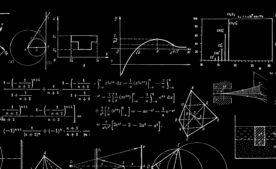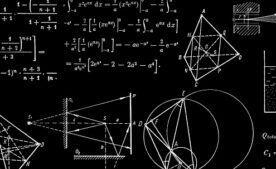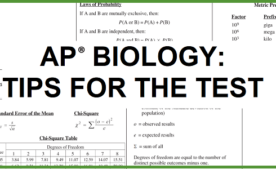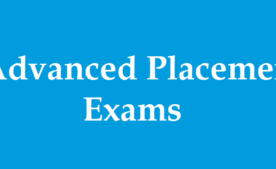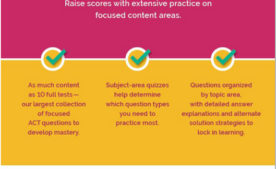Nearly every high school junior and senior is aware that AP exams occur during the first two weeks in May. These optional exams are offered as an end of program assessment for AP courses taken during the school year. Some colleges and universities award credit and class placement based on AP scores. While most selective schools have moved away from issuing course credit for high scores, they will still use scores of 3 or higher for placement or to waive a prerequisite.
Typically, the study period for AP exams begins in late February or early March and continues to May. Most students find that working one-on-one with a tutor is the most effective way to prepare. Contact us today to learn more about our AP tutoring programs.
AP Exam Descriptions By Subject
AP Art History
| Timing | Format | Content |
|---|---|---|
| 3 hours – Multiple-choice section (1 hour) – Free-response section (2 hours) | Section I • 80 multiple-choice questions Section II 2 long essay questions (35 minutes for first, 25 minutes for second) 4 short essay questions (15 minutes) | Multiple-choice questions assess students’ ability to identify works, artists, and cultures from 250 works of art, apply art historical skills to make deductions about unfamiliar works of art, and demonstrate critical analysis skills while applying an understanding of art historical concepts. Essay questions ask students to demonstrate understanding of complex issues, discuss multiple aspects of artworks, and analyze relationships among works of art. All free-response questions include either images of works of art or a list of works. |
AP biology
| Timing | Format | Content |
|---|---|---|
| 3 hours – Multiple-choice section (1 hour, 30 minutes) – Free-response section (1 hour, 30 minutes) | Section I 60 multiple-choice questions Section II 2 long free-response questions 4 short free-response questions | Section I consists of multiple-choice questions that represent knowledge and science practices. Section I I consists of questions focusing on interpretation and evaluation of experimental results, scientific investigation, conceptual analysis, analysis of a model or visual representation, and analysis of data. |
AP CALCULUS
| Timing | Format | Content |
|---|---|---|
| 3 hours, 15 minutes – Multiple-choice section (1 hour, 45 minutes) – Free-response section (1 hour, 30 minutes) | Section I Part A — 30 multiple-choice questions (60 minutes) Part B — 15 multiple-choice questions (45 minutes) Section II Part A — 2 free-response questions (30 minutes) Part B — 4 free-response questions (60 minutes) | Section I consists of multiple-choice questions designed for broad coverage of AP Calculus. Section I, Part A, does not permit use of a graphing calculator. Section I, Part B, permits use of a graphing calculator. Section II consists of free-response questions that provide students with an opportunity to demonstrate their knowledge of correct mathematical reasoning and thinking. Students are required to articulate the reasoning and methods that support their answers. Some questions will ask students to justify an answer or discuss whether a theorem can be applied. Section II, Part A, permits use of a graphing calculator. Section II, Part B, does not permit use of a graphing calculator. |
AP CHEMISTRY
| Timing | Format | Content |
|---|---|---|
| 3 hours, 15 minutes – Multiple-choice section (1 hour, 30 minutes) – Free-response section (1 hour, 45 minutes) | Section I 60 multiple-choice questions Section II 3 long free-response questions 4 short free-response questions | Section I consists of multiple-choice questions, either as discrete questions or question sets, that represent the AP Chemistry knowledge and science practices. Section II consists of free-response questions that pertain to experimental design, analysis of authentic lab data and observations to identify patterns or explain phenomena, creating or analyzing atomic and molecular views to explain observations, articulating and translating between representations, and following a logical/analytical pathway to solve a problem. Students will be allowed to use a scientific calculator on the free-response section. |
AP COMPARATIVE GOVERNMENT & POLITICS
| Timing | Format | Content |
|---|---|---|
| 2 hours, 30 minutes – Multiple-choice section (1 hour) – Free-response section (1 hour, 30 minutes) | Section I • 40 multiple-choice questions Section II • 4 free-response questions | The two sections require students to demonstrate their ability to solve problems, including their ability to design, write, and analyze programs and subprograms. All responses involving code must be written in Java. Questions cover content in primitive types, using objects, Boolean expressions, iteration, writing classes, array, inheritance, and recursion. |
AP COMPUTER SCIENCE PRINCIPLES
| Timing | Format | Content |
|---|---|---|
| Create Performance Task – 12 hours End-of-Course Exam – 2 hours | 70 multiple-choice questions 62 single-select — students select one answer from among four options 8 multi-select — students select two answers from among four options | In the Create Performance Task, students will develop a program on a topic that interests them or solves a problem. Exam questions cover creativity, abstraction, data and information, algorithms, programming, the internet, and global impact. |
AP ECONOMICS
| Timing | Format | Content |
|---|---|---|
| 2 hours, 10 minutes – Multiple-choice section (1 hour, 10 minutes) – Free-response section (1 hour, beginning with a 10-minute reading period) | Section I 60 multiple-choice questions Section II 1 long free-response question 2 short free-response questions | The AP Microeconomics questions cover content in basic economic concepts, the nature and functions of product markets, factor markets, and market failure and the role of government. The AP Macroeconomics questions cover content in basic economic concepts, economic performance, income and price determination, the financial sector, stabilization policies, growth, and the open economy. |
AP ENGLISH LANGUAGE & COMPOSITION
| Timing | Format | Content |
|---|---|---|
| 3 hours, 15 minutes – Multiple-choice section (1 hour) – Free-response section (2 hours, 15 minutes) | Section I 45 multiple-choice questions Section II 3 essay prompts | Section I consists of five sets of multiple-choice questions covering reading and writing skills. Section II consists of three essay prompts that require students to address an issue by synthesizing texts, analyzing rhetoric, or composing an argument supported by evidence and reasoning from observations and experiences. |
AP ENGLISH LITERATURE & COMPOSITION
| Timing | Format | Content |
|---|---|---|
| 3 hours – Multiple-choice section (1 hour) – Free-response section (2 hours) | Section I 55 multiple-choice questions Section II 3 free-response questions | Section I consists of 5 sets of multiple-choice questions that test students’ critical reading of selected prose fiction and poetry passages. Section II consists of essay prompts that require writing as a direct measure of students’ ability to read and interpret literature and to use other forms of discourse effectively. |
AP EUROPEAN HISTORY
| Timing | Format | Content |
|---|---|---|
| 3 hours, 15 minutes – Multiple-choice and short-answer section (1 hour, 35 minutes) – Free-response section (1 hour, 40 minutes) | Section I Part A — 55 multiple-choice questions (55 minutes) Part B — 3 short-answer questions (40 minutes) Section II Part A — document-based question (60 minutes) Part B — long essay question (40 minutes) | Section I, Part A consists of multiple-choice questions that ask students to respond to a primary or secondary source, such as texts, images, charts, graphs, or maps, reflecting material historians use in studying the past. Section I, Part B consists of short-answer questions. The first question includes a secondary source and the second includes a primary source, with both questions covering historical developments or processes between the years 1600 and 2001. Students then choose to answer the third or fourth question, which cover the years 1450-1815 and 1815-2001, respectively, and include no sources. Section II, Part A consists of an essay question that covers the years 1600-2001 and measures students’ ability to develop an argument using historical material as evidence. Section II, Part B consists of a choice among three long essay questions, each addressing a different time period. |
AP HISTORY (U.S. HISTORY OR WORLD HISTORY: MODERN)
| Timing | Format | Content |
|---|---|---|
| 3 hours, 15 minutes Multiple-choice and short answer section (1 hour, 35 minutes) Free-response section (1 hour, 40 minutes) | Section I Part A — 55 multiple-choice questions (55 minutes) Part B — 3 short-answer questions (40 minutes) Section II Part A — 1 document-based question (60 minutes) Part B — 1 long essay question (40 minutes) | Section I, Part A consists of multiple-choice questions organized into sets of three to four questions. The questions in each set ask students to respond to a primary or secondary source, such as written texts, images, charts, graphs, or maps. Section I, Part B consists of four short-answer questions. Students must answer the first and second questions and then either the third or fourth question. The first question assesses the practice of analyzing secondary sources, while the second question assesses the practice of analyzing primary sources. The third and fourth questions deal with different periods and ask students to respond to general propositions about history. Section II, Part A asks students to develop and support an argument using historical source material as evidence. Section II, Part B consists of three long essay questions about different periods. Students must choose one essay to write and must develop an argument and support it with an analysis of historical evidence. |
AP HUMAN GEOGRAP
| Timing | Format | Content |
|---|---|---|
| 2 hours, 15 minutes Multiple-choice section (1 hour) Free-response section (1 hour, 15 minutes) | Section I 60 multiple-choice questions Section II 3 free-response questions | Questions range in difficulty from those asking students to recognize the meaning of terms and concepts to those requiring students to apply a model or concept to a new scenario. Many of the questions are based on a table, map, diagram, or photograph. Free-response questions assess students’ ability to describe, explain, and apply geographic concepts as they analyze patterns, relationships, and outcomes. |
AP LANGUAGE AND CULTURE (FRENCH, GERMAN, ITALIAN, OR SPANISH)
| Timing | Format | Content |
|---|---|---|
| 3 hours, 3 minutes Multiple-choice section (1 hour, 35 minutes) Free-response section (1 hour, 28 minutes) | Section I 30 print-based multiple-choice questions 35 audio-based multiple-choice questions Section II 2 written free-response questions 2 spoken free-response questions | Section I consists of multiple-choice questions based on a variety of print and audio materials to assess interpretive communication. Section II requires students to read and reply to an email message, write a persuasive essay based on multiple sources with different viewpoints on a topic, respond to questions as part of a simulated conversation, and make a presentation in response to a prompt on a cultural topic. |
AP LANGUAGE AND CULTURE (CHINESE OR JAPANESE)
| Timing | Format | Content |
|---|---|---|
| 2 hours, 1 minute Multiple-choice section (1 hour, 20 minutes) Free-response section (41 minutes) | Section I Chinese 30–40 print-based multiple- choice questions 25–35 audio-based multiple-choice questions Japanese 35–40 print-based multiple-choice questions 30–35 audio-based multiple-choice questions Section II 2 written free-response questions 2 spoken free-response questions | Section I consists of 70 multiple-choice questions, including questions with a listening selection stimulus and questions with a reading selection stimulus. The Chinese test includes rejoinders. Section II consists of free responses. The Chinese test includes a story narration, email response, conversation, and cultural presentation. The Japanese test includes a text chat, compare and contrast article, conversation, and cultural perspective presentation. |
AP LATIN
| Timing | Format | Content |
|---|---|---|
| 3 hours Multiple-choice section (1 hour) Free-response section (2 hours, including a 15-minute reading period) | Section I 50 multiple-choice questions Section II 5 free-response questions | Section I consists of 50 multiple-choice questions that test reading and comprehension as well as a student’s ability to place texts within Roman historical, cultural, and literary contexts. Section II consists of 2 free-response questions focused on translation, one analytical essay in which students must perform textual analysis to compare two passages, and two short-answer question sets that assess on argumentation, contextualization, and reading and comprehension. |
AP MUSIC THEORY
| Timing | Format | Content |
|---|---|---|
| 2 hours, 40 minutes Multiple-choice section (1 hour, 20 minutes) Free-response section (1 hour, 20 minutes) | Section I 75 multiple-choice questions Section II 7 free-response questions 2 sight-singing questions | Questions based on aural stimulus test a student’s listening skill and knowledge about theory largely in the context of historical examples. Questions not based on aural stimulus focus on small-scale and large-scale harmonic procedures, melodic organization and developmental procedures, rhythmic/metric organization, texture, and formal devices. |
AP PHYSICS (1 OR 2)
| Timing | Format | Content |
|---|---|---|
| 3 hours Multiple-choice section (1 hour, 30 minutes) Free-response section (1 hour, 30 minutes) | Section I Part A — 45 single-select questions Part B — 5 multi-select questions Section II 5 free-response questions (Physics 2 exam has 4 free-response questions) | Section I consists of multiple-choice questions, either as discrete questions, questions in sets, or multi-select questions. Section II consists of three types of free-response questions: • 1 experimental design question — designing and describing an investigation, analysis of authentic lab data, and observations to identify patterns or explain phenomena. • 1 qualitative/quantitative translation — translating between quantitative and qualitative justification and reasoning. • 3 short-answer (Physics 2 exam has 2 short-answer questions). |
AP PHYSICS C – MECHANICS
| Timing | Format | Content |
|---|---|---|
| 1 hour, 30 minutes Multiple-choice section (45 minutes) Free-response section (45 minutes) | Section I 35 multiple-choice questions Section II 3 free-response questions | Section I emphasizes the breadth of the students’ knowledge and understanding of the basic principles of physics. Section II emphasizes the application of physics principles in greater depth in solving more extended problems. Questions cover directions of vectors or paths of particles, drawing or interpreting diagrams, physical relationships in graphical form, accounting for observed phenomena, interpreting experimental data, conceptual models, predicting future physical behavior, manipulating equations, estimates, or deriving relationships from fundamental physical concepts. |
AP PSYCHOLOGY
| Timing | Format | Content |
|---|---|---|
| 2 hours Multiple-choice section (1 hour, 10 minutes) Free-response section (50 minutes) | Section I 100 multiple-choice questions Section II 2 free-response questions | Section I questions cover content in psychology history and approaches, research methods, biological bases of behavior, sensation and perception, states of consciousness, learning, cognition, motivation and emotion, developmental psychology, personality, testing and individual differences, abnormal behavior, treatment, and social psychology. Section II has a question that requires students to explain behavior and apply theories in context and a question that requires students to analyze psychological research studies. |
AP STATISTICS
| Timing | Format | Content |
|---|---|---|
| 3 hours Multiple-choice section (1 hour, 30 minutes) Free-response section (1 hour, 30 minutes) | Section I 40 multiple-choice questions Section II 5 free-response questions 1 investigative task | Students are expected to bring a graphing calculator with statistical capabilities. Section I consists of multiple-choice questions, either as discrete questions or sets of questions based on a shared prompt. Section II consists of free-response questions that require students to use their analytical, organizational, and communication skills to relate two or more content areas. |

